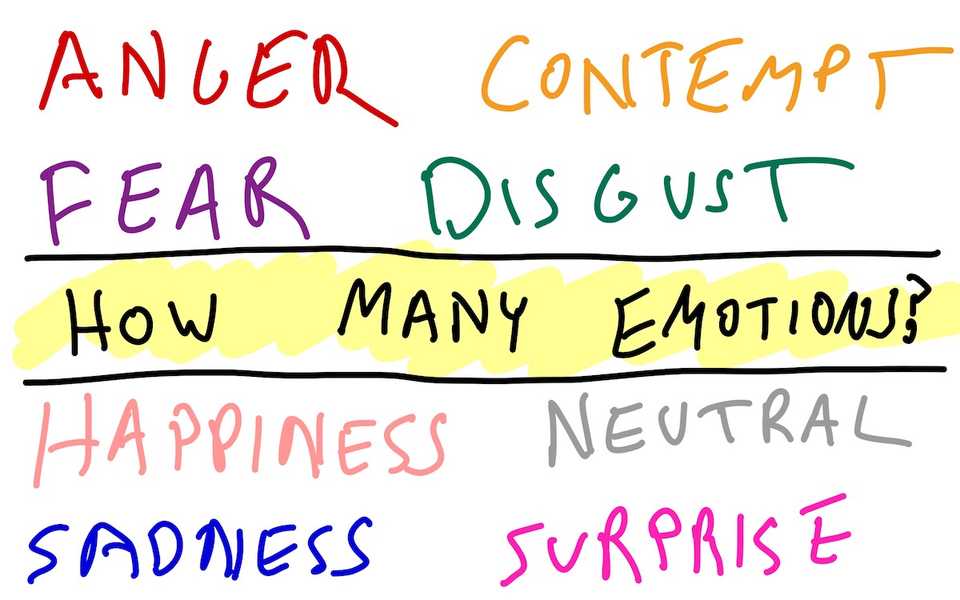How many emotions are there, really?
After a conversation with a colleague about emotional triggers in marketing, I wondered: can we use machine learning to understand and create a hierarchy of emotions?
Previous attempts had come to various conclusions.
DepecheMood
In 2014, a team of researches came out with a group of core emotions called DepecheMood. They identified these core emotions:
- Afraid
- Amused
- Angry
- Annoyed
- Happy
- Inspired
- Sad
- Don’t care
The Paul Ekman List
The emotion researcher Paul Ekman surveyed 139 emotions researchers and found that:
All those who chose both approaches, in addition to those who had chosen only the discrete choice (a total of 74% of those surveyed), were asked which emotion labels (out of a list of 18) should be considered to have been empirically established. There was high agreement about five emotions (all of which were described by both Darwin and Wundt): anger (91%), fear (90%), disgust (86%), sadness (80%), and happiness (76%). Shame, surprise, and embarrassment were endorsed by 40%–50%. Other emotions, currently under study by various investigators drew substantially less support: guilt (37%), contempt (34%), love (32%), awe (31%), pain (28%), envy (28%), compassion (20%), pride (9%), and gratitude (6%).
In its face recognition AI, Microsoft has relied on this list from Dr. Ekman:
- Anger
- Contempt
- Fear
- Disgust
- Happiness
- Neutral
- Sadness
- Surprise
The Video Subjects List
Two Berkeley researchers (Alan S. Cowen and Dacher Keltner) captured a list of emotions by showing videos to subjects and categorizing the emotions they reported. They identified 27 different emotions:
- Admiration
- Adoration
- Aesthetic Appreciation
- Amusement
- Anger
- Anxiety
- Awe
- Awkwardness
- Boredom
- Calmness
- Confusion
- Contempt
- Craving
- Disappointment
- Disgust
- Empathic Pain
- Entrancement
- Envy
- Excitement
- Fear
- Guilt
- Horror
- Interest
- Joy
- Nostalgia
- Pride
- Relief
- Romance
- Sadness
- Satisfaction
- Sexual Desire
- Surprise
- Sympathy
- Triumph
What strikes me about this is the number of emotions that don’t have a proper noun associated with them. “Empathic pain” is easy to evoke, but the word that usually comes to mind is “cringeworthy.” I have little aesthetic appreciation for the phrase “aesthetic appreciation”—in fact, it gives me empathic pain. “Sexual desire,” too.
Word Embeddings To the Rescue
The Technique
To do this, I used a technique called word embeddings. Word embeddings learns the meaning of words by trying to guess what word you might use if you were to “blank” out that word. For instance, if I wrote “the quick brown X jumped over the lazy dog,” you might guess that X is fox—or less likely, something else that’s quick and jumps, like sheep. The technique is smart enough to interchange words that might be used in the same context, but might interchange near antonyms, like “cocky” and “timid.”
Visualization #1: The “Clusters” List
The cluster names in the graphics look for the emotion most close to the middle of the cluster. I changed some of them to summarize the theme I observed in each cluster.
14 Emotion Types and a Grab Bag of Others
- Suffering (cruelty, torture, grief, denial)
- Smug (jealousy, lucky, pride)
- Despondent (frazzled, fatigued, suffocated)
- Amused (wonder, joy, love)
- Interested ( Inspired, challenged, energetic, even afraid)
- Jocund (lighthearted, exuberant, quizzical; conversely, downcast, introspective, pensive)
- Strong (bold, brave, powerful; conversely, weak)
- Fervent (astonished, vindictive, testy, chary)
- Liking (warmth, protective, adoring)
- Excluded (cynical, dubious, intimidated, bothered)
- Antsy (giddy, ecstatic, pumped, nervous)
- Moved (speechless, elated, horrified, appalled, petrified)
- Jolly (zesty, merry, bubbly, serene)
- Alert (snappy, sullen, alarmed, paranoid, tense)
- Grab bag: calm, torn, hyper, lusty, ire, numb.
Click for higher resolution image.
Not bad for a machine that doesn’t know a thing about humans!
A Different Attempt
I originally tried with a different attempt, which clustered each emotion hierarchically, but did so by forking them into groups of 2 over and over again. (That’s why the image looks like a big, complicated fork.) Each color represents a different cluster. Here is the first take; the result is chaotic, but creates an mosaic of our rich vocabulary for emotions:
Click for higher resolution image.
Feeling Words and Eskimo Words for Snow, and Affect Labeling
тоска is a Russian word that means “boredom” or “melancholy” or “yearning” or “ennui.” Waldeinsamkeit is a German word that describes the warm connected feeling one gets when alone in the woods. Kilig is a Tagalog word for the butterflies you feel in your stomach during early romance.
Even though Eskimos don’t really have more words for snow than English-speakers do, there is a surprising range of emotional words in different languages.
English doesn’t seem to have a single word for “empathetic pain” or “aesthetic appreciation,” although I have certainly experienced those feelings. Putting feelings into words, or “affect labeling,” is an effective way to attenuate our emotional experiences and regulate our emotions.
I am forced to wonder: do people feel differently in different languages?


